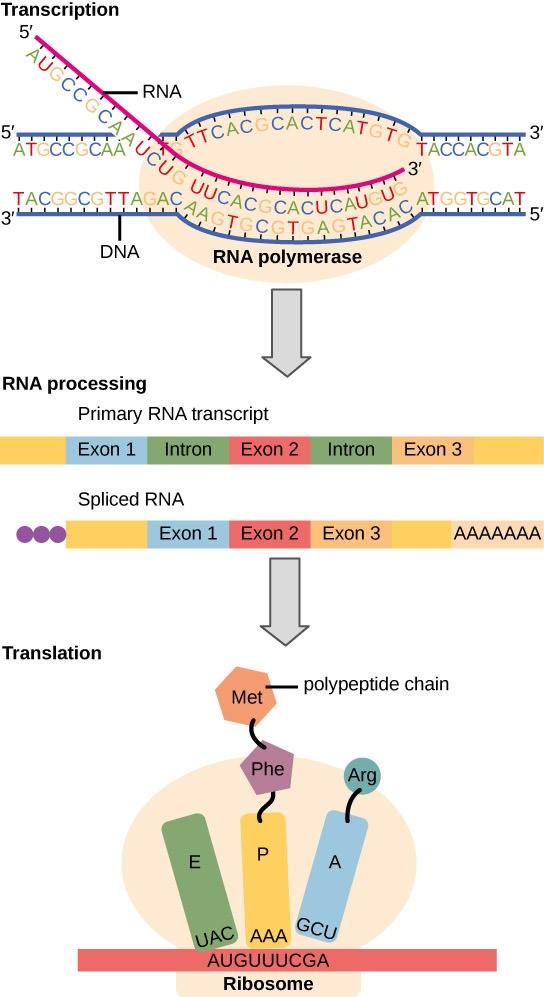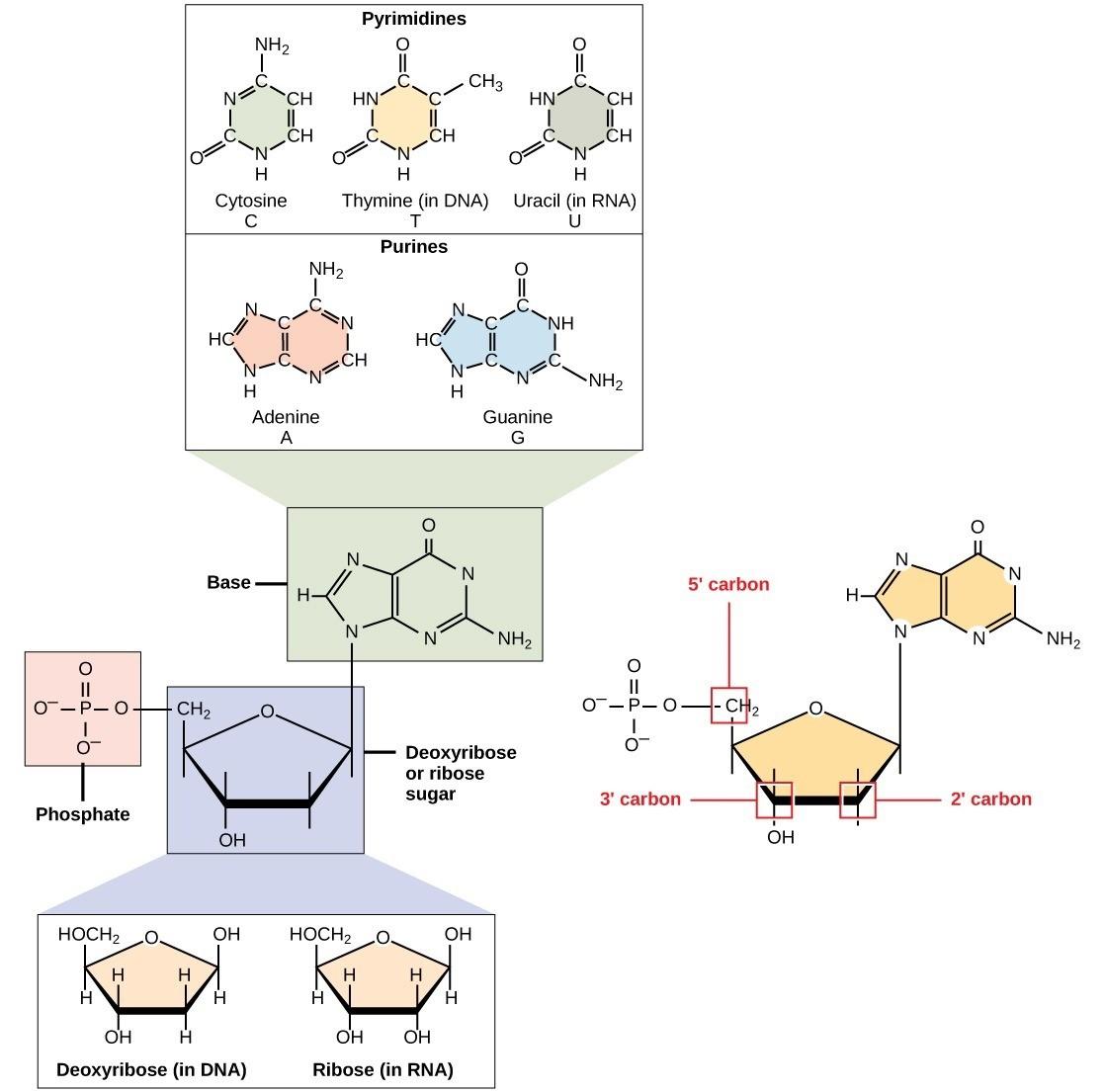15 Chapter 15: Central Dogma
Lisa Limeri and Joshua Reid
Learning Objectives
By the end of this section, you will be able to do the following:
- List the diverse functions of proteins within a cell.
- Describe the different types of RNA molecules found in the cell.
- Make a flow chart summarizing the flow of information in cells from gene to protein. Label arrows connecting mRNA, DNA, and proteins, and explain what each arrow represents.
- Compare the structure, chemical composition, location, and function of DNA with RNA.
- Given a specific change in a DNA coding strand or a specific error in transcription or translation, predict the consequences for the gene product.
Introduction
Unit 1 focused on how organisms grow and maintain themselves by replicating their cells. We focused specifically on DNA – how it is replicated (S phase) and then moved into two new daughter cells (M phase). But why do we care about DNA? DNA’s primary function – the storage of information for how to create proteins – will be the primary focus of Unit 3. Let’s dive in!
Proteins: Not Just About Muscles
Proteins are one of the most abundant organic molecules in living systems and have the most diverse range of functions of all macromolecules. Proteins may be structural, regulatory, contractile, or protective. They may serve in transport, storage, or membranes, or they may be toxins or enzymes. Each cell in a living system may contain thousands of proteins, each with a unique function. Their structures, like their functions, vary greatly. They are all, however, amino acid polymers arranged in a linear sequence.
Enzymes, which living cells produce, are catalysts in biochemical reactions (like digestion) and are usually complex or conjugated proteins. Each enzyme is specific for the substrate (a reactant that binds to an enzyme) upon which it acts. The enzyme may help in breakdown, rearrangement, or synthesis reactions. We call enzymes that break down their substrates catabolic enzymes, while those that build more complex molecules from their substrates are anabolic enzymes. All enzymes increase the reaction rate and, therefore, are organic catalysts. An example of an enzyme is salivary (i.e., in your saliva) amylase, which hydrolyzes (i.e., breaks down) its substrate, amylose, which is a starch component.
Hormones are chemical-signaling molecules, usually small proteins or steroids, secreted by endocrine cells that act to control or regulate specific physiological processes, including growth, development, metabolism, and reproduction. For example, insulin is a protein hormone that helps regulate blood glucose levels.
While enzymes and hormones are two essential types of proteins, there are many more! Table 15.1 lists some more types and functions of proteins.
Table 15.1 Protein Types and Functions
|
Protein Type |
Example |
Example Function |
|
Digestive Enzymes |
Amylase, lipase, pepsin, trypsin |
Hydrolyzes nutrients into smaller units for absorption. |
|
Transport |
Hemoglobin, albumin |
Carry substances in the blood or lymph throughout the body |
|
Structural |
Actin, tubulin, keratin |
Construct different structures, like the cytoskeleton |
|
Hormones |
Insulin, thyroxine |
Coordinate different body systems’ activity |
|
Defense |
Immunoglobulins |
Protect the body from foreign pathogens |
|
Contractile |
Actin, myosin |
Effect muscle contraction |
|
Storage |
Legume storage proteins, egg white (albumin) |
Provide nourishment in early embryo development, and the seedling |
The Central Dogma: DNA Encodes RNA; RNA Encodes Protein

The flow of genetic information in cells from DNA to mRNA to protein is described by the central dogma (Figure 15.1). The central dogma states that genes specify the sequence of nucleotides making up mRNAs, which in turn specify the sequence of amino acids making up proteins. Because the information stored in DNA is so critical to cellular function, it makes intuitive sense that the cell would make mRNA copies of this information for protein synthesis, while keeping the DNA itself protected.
Genes are sequences of DNA that contain the information for the sequence of amino acids to make up proteins. They are linearly arranged on chromosomes. Both genes and the proteins they encode are absolutely essential to life as we know it, which is why the expression of genes is referred to as the central dogma of biology. The copying of DNA to RNA is relatively straightforward, with one nucleotide being added to the messenger RNA (mRNA) strand for every nucleotide read in the DNA strand. This process is called transcription (Figure 15.2). After processing the mRNA, the cell uses a three-base sequence of nucleotides called codons within mRNA to direct the amino acid sequence of polypeptides. This process is called translation and is carried out by ribosomes, with the help of tRNAs and rRNAs. The folding of these polypeptide chains into their final three-dimensional form produces the functional version of the protein.

RNA is Distinct from DNA
The central dogma involves mRNA, rRNA, and tRNA – three different types of RNA. Clearly, RNA is critical for understanding the central dogma. So let’s first learn a bit more about RNA, and how it’s similar to and different from DNA.
In unit 1, we learned a lot about DNA’s structure in order to understand its function as information storage. A second nucleic acid, called ribonucleic acid or RNA, is a single-stranded molecule similar in structure to DNA, but with some key differences. Like DNA, RNA is composed of nucleotides that are linked by phosphodiester bonds. Each nucleotide has the same basic structure: a sugar attached to a base and one or more phosphates (Figure 15.3)
However, there are some key differences between RNA and DNA. First, while DNA is typically double-stranded, RNA is typically single-stranded. Second, DNA is made up of deoxyribonucleotides whereas RNA is composed of ribonucleotides. The distinction is the type of sugar that is attached to the base (ribose in RNA, deoxyribose in DNA). Third, DNA contains the bases Adenine (A), Thymine (T), Cytosine (C), and Guanine (G). RNA does not contain Thymine (T), and in its place uses Uracil (U) instead. Thus, the base pairs in RNA are A-U and C-G.

There are four major types of RNA: messenger RNA (mRNA), ribosomal RNA (rRNA), transfer RNA (tRNA), and microRNA (miRNA). The first, mRNA, carries the information encoded in DNA. If a cell requires synthesizing a certain protein, the gene for this product turns “on” and the mRNA is synthesized based on the sequence of nucleotides in the DNA in the nucleus. The mRNA base sequence is complementary to the DNA sequence from which it has been copied. However, in RNA, the base T is absent and U is present instead. For example, if the DNA strand has a sequence AATTGCGC, the sequence of the complementary RNA is UUAACGCG.
Table 15.2 The Base Pairing Rules of Transcription. The base-pairing rules slightly differ from that of DNA replication. Because RNA uses uracil (U) instead of thymine (T) as one of its pyrimidines, A in the DNA template pairs with U in RNA.
|
Base found in DNA |
Base inserted into RNA |
|
A |
U |
|
T |
A |
|
C |
G |
|
G |
C |
Ribosomal RNA (rRNA) is a major constituent of ribosomes, the protein synthesis machines of the cell. Ribosomes are a complex of molecules that use the information encoded in mRNA to connect amino acids in the correct sequence. A key part of this process is the translation of the nucleotide sequence into an amino acid sequence. There are only 4 nucleotides and 20 amino acids, so a grouping of 3 nucleotides is used to determine the correct amino acid (more on this when we dive into the details of translation). This is done by transfer RNA (tRNA). There are many different types of tRNA, each of which carries a particular amino acid and its corresponding nucleotide triplet.
MicroRNAs are the smallest RNA molecules and their role involves regulating gene expression by interfering with the expression of certain mRNA messages.
Acknowledgements
Adapted from Clark, M.A., Douglas, M., and Choi, J. (2018). Biology 2e. OpenStax. Retrieved from https://openstax.org/books/biology-2e/pages/1-introduction

